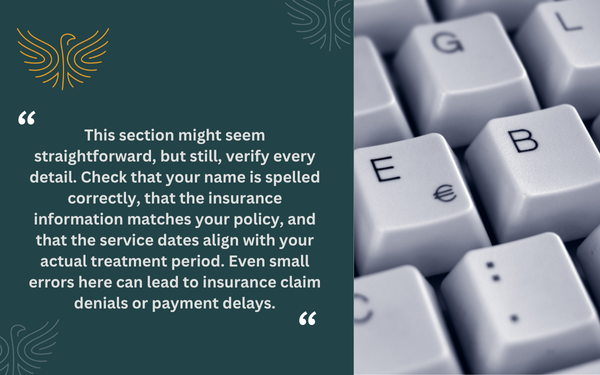Opening a rehab bill can feel like reading a foreign language. After the emotional and physical exhaustion of treatment, the last thing you need is financial confusion adding to your stress. So, what does each line mean exactly?
Let’s break down a typical rehab bill, line by line, so you know exactly what you're paying for—and how to spot potential issues!
_______________________________________________________
The Overview Section: Understanding the Header
The top portion of your bill contains essential identifying information that confirms who the bill is for and what it covers. You’ll typically see the facility name and address, your name as the patient, an account number unique to your stay, and the specific dates of service covered by this bill. There’s also an invoice or statement date (when the bill was generated) and the total amount due.
This section might seem straightforward, but still, verify every detail. Check that your name is spelled correctly, that the insurance information matches your policy, and that the service dates align with your actual treatment period. Even small errors here can lead to insurance claim denials or payment delays.

_______________________________________________________
The Charges Section: Core Treatment Costs
This section represents the heart of your bill and typically the largest portion of charges.
“Room and Board” covers your housing, meals, and basic amenities during residential treatment. This daily charge varies widely between facilities based on location and level of care.
“Detox Services” includes medical supervision during withdrawal, medications to manage symptoms, and monitoring of vital signs.
“Therapy Sessions” encompasses individual, group, and family therapy, which may be billed per session or bundled into a daily rate.
“Medical or Psychiatric Evaluations” covers initial assessments and ongoing evaluations by doctors or specialists.
Compare these charges against your actual treatment schedule. If your bill shows daily group therapy but you only attended three times a week, that’s worth questioning. Some facilities use an all-inclusive daily rate while others itemize each service separately—knowing which billing method your facility uses helps you understand whether charges are accurate.
_______________________________________________________
The Medications and Supplies Section
This section lists every medication administered during your stay, including prescription drugs, over-the-counter pain relievers, and vitamins. You might see medications for withdrawal management, mental health support, or treatment of co-occurring medical conditions.
Medical supplies such as wound care items, testing strips, and nutritional supplements also appear here.
Carefully review medication names and quantities. If you brought your own prescriptions or had them filled outside the facility, ensure you’re not being double-billed.
_______________________________________________________
The Laboratory and Testing Section
Drug screenings, blood work, and other diagnostic tests appear in this section. These might include initial health assessments, regular drug tests throughout treatment, tests for infectious diseases, or monitoring of medication levels.
Check whether your insurance covers laboratory services under your specific plan—sometimes these require separate authorization or have different coverage limits. And keep in mind that toxicology panels (urine drug tests) often appear multiple times per week.
_______________________________________________________
The Therapy and Specialty Services Section
Beyond standard treatment, many facilities offer specialized therapeutic services that appear as separate line items. Cognitive Behavioral Therapy (CBT) might be listed separately from general counseling. Experiential therapies such as art, music, or equine-assisted therapy often incur additional charges.
Physical therapy, occupational therapy, or specialized trauma treatments may also appear here. Aftercare planning and case management services, however, are sometimes billed separately.
Review which services were included in your initial treatment agreement versus what might have been optional add-ons. Some facilities include all therapies in their base rate, while others charge extra for specialized services.
If you see unfamiliar abbreviations like “PHP” (Partial Hospitalization Program) or “IOP” (Intensive Outpatient Program), ask for plain-language explanations of what these services involve and when they were provided.
_______________________________________________________
The Insurance Adjustment Section
This section often causes the most confusion. So, let’s get right into it.
“Billed Charges” shows the total cost before any insurance involvement—this is rarely what anyone actually pays. “Insurance Payment” or “Insurance Adjustment” indicates what your insurer has agreed to cover based on your policy and their contract with the facility. Meanwhile, “Patient Responsibility” is what you owe after insurance adjustments, including deductibles, copayments, and coinsurance.
Compare this section carefully with the Explanation of Benefits (EOB) you receive from your insurance company. The numbers should match. If there’s a discrepancy or if insurance payments seem missing, contact both the facility’s billing office and your insurance company immediately.
_______________________________________________________
The Balance and Payment Options Section
This final section summarizes what you owe after all insurance adjustments. You’ll see your remaining balance, the payment due date, and accepted payment methods. Many facilities also include information about financial assistance programs or payment plan options.
If the balance feels unmanageable, reach out to the billing department immediately—don’t wait until the due date. Most treatment centers offer flexible repayment plans, sliding scale fees based on income, or hardship assistance programs. Early communication demonstrates good faith and helps you avoid collections, late fees, or damage to your credit.
Remember, you've already done the hardest work by completing treatment. Understanding your bill is just one more step in building a stable, sustainable recovery.
If you need help understanding your rehab bill or navigating insurance, our admissions and billing specialists at Freedom Recovery Centers (FRC) can help answer your questions. Or if you or a loved one needs help throughout the recovery process, call us at 804-635-3746. We can help you take those initial first steps toward a more fulfilling and healthier life!
.svg)






.svg)

.svg)



.svg)
